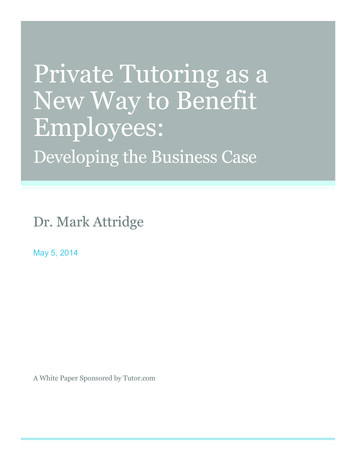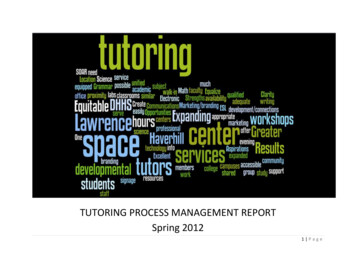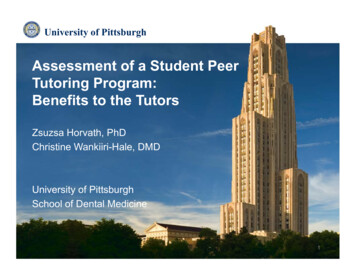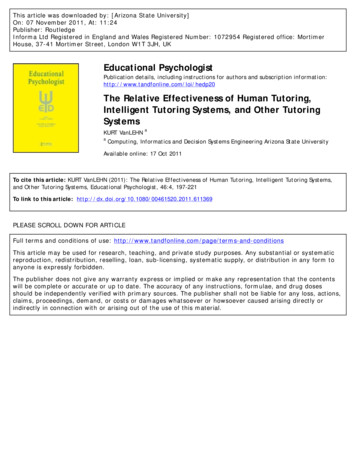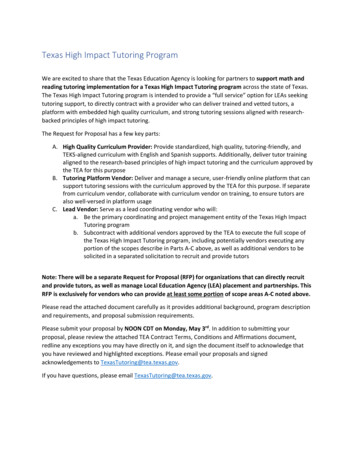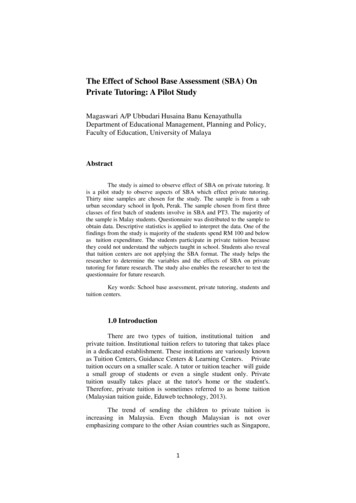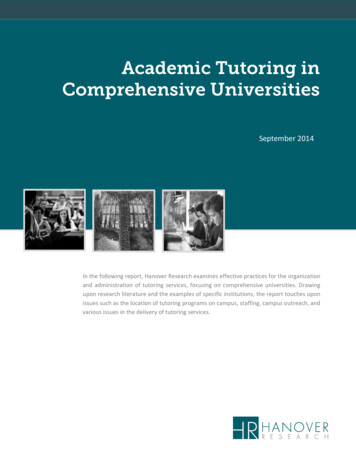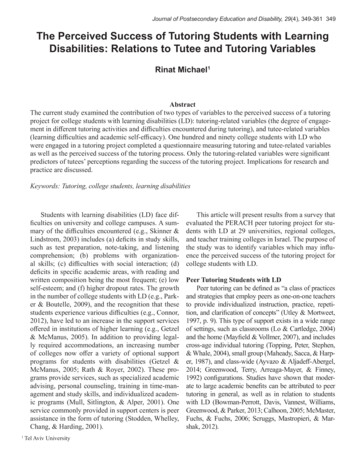
Transcription
Journal of Postsecondary Education and Disability, 29(4), 349-361 349The Perceived Success of Tutoring Students with LearningDisabilities: Relations to Tutee and Tutoring VariablesRinat Michael1AbstractThe current study examined the contribution of two types of variables to the perceived success of a tutoringproject for college students with learning disabilities (LD): tutoring-related variables (the degree of engagement in different tutoring activities and difficulties encountered during tutoring), and tutee-related variables(learning difficulties and academic self-efficacy). One hundred and ninety college students with LD whowere engaged in a tutoring project completed a questionnaire measuring tutoring and tutee-related variablesas well as the perceived success of the tutoring process. Only the tutoring-related variables were significantpredictors of tutees’ perceptions regarding the success of the tutoring project. Implications for research andpractice are discussed.Keywords: Tutoring, college students, learning disabilitiesStudents with learning disabilities (LD) face difficulties on university and college campuses. A summary of the difficulties encountered (e.g., Skinner &Lindstrom, 2003) includes (a) deficits in study skills,such as test preparation, note-taking, and listeningcomprehension; (b) problems with organizational skills; (c) difficulties with social interaction; (d)deficits in specific academic areas, with reading andwritten composition being the most frequent; (e) lowself-esteem; and (f) higher dropout rates. The growthin the number of college students with LD (e.g., Parker & Boutelle, 2009), and the recognition that thesestudents experience various difficulties (e.g., Connor,2012), have led to an increase in the support servicesoffered in institutions of higher learning (e.g., Getzel& McManus, 2005). In addition to providing legally required accommodations, an increasing numberof colleges now offer a variety of optional supportprograms for students with disabilities (Getzel &McManus, 2005; Rath & Royer, 2002). These programs provide services, such as specialized academicadvising, personal counseling, training in time-management and study skills, and individualized academic programs (Mull, Sitlington, & Alper, 2001). Oneservice commonly provided in support centers is peerassistance in the form of tutoring (Stodden, Whelley,Chang, & Harding, 2001).1Tel Aviv UniversityThis article will present results from a survey thatevaluated the PERACH peer tutoring project for students with LD at 29 universities, regional colleges,and teacher training colleges in Israel. The purpose ofthe study was to identify variables which may influence the perceived success of the tutoring project forcollege students with LD.Peer Tutoring Students with LDPeer tutoring can be defined as “a class of practicesand strategies that employ peers as one-on-one teachersto provide individualized instruction, practice, repetition, and clarification of concepts” (Utley & Mortweet,1997, p. 9). This type of support exists in a wide rangeof settings, such as classrooms (Lo & Cartledge, 2004)and the home (Mayfield & Vollmer, 2007), and includescross-age individual tutoring (Topping, Peter, Stephen,& Whale, 2004), small group (Maheady, Sacca, & Harper, 1987), and class-wide (Ayvazo & Aljadeff‐Abergel,2014; Greenwood, Terry, Arreaga-Mayer, & Finney,1992) configurations. Studies have shown that moderate to large academic benefits can be attributed to peertutoring in general, as well as in relation to studentswith LD (Bowman-Perrott, Davis, Vannest, Williams,Greenwood, & Parker, 2013; Calhoon, 2005; McMaster,Fuchs, & Fuchs, 2006; Scruggs, Mastropieri, & Marshak, 2012).
350 Michael; Tutoring Students with LDDespite its prevalence, the effectiveness of peertutoring in general and tutoring college studentswith LD in particular has not been thoroughly examined. Past research has suggested that since typically there are fewer differences in age and status,more mutuality of interaction, and relationships of alonger duration (Kram & Isabella, 1985), peer relationships may serve in a supportive capacity relatedto both career advancement and psychosocial functioning. As for tutoring college students with LD,Zwart and Kallemeyn (2001) found that participation in a peer tutoring program contributed to a general feeling of efficacy and to a greater use of learning strategies and skills. Gimblett (2000) reported animprovement in self-image and a smooth transitionto college life among the tutees. Vogel, Fresko, andWertheim (2007) found that both tutees and tutorsperceived tutoring as very beneficial to the tutees,and the level of satisfaction with the tutoring program for both groups was high. However, not muchis known regarding the variables which contribute tothe success of the tutoring process.The purpose of this study was to identify variableswhich may influence the perceived success of the tutoring project to college students with LD. Specifically, two types of variables were examined: tutoring-related (the degree of engagement in different tutoringactivities and difficulties encountered during tutoring),and tutee-related (learning difficulties and academicself-efficacy).Antecedents of Tutoring Success for Students withLDAccording to Daiute and Dalton (1993), what permits development in peer tutoring settings is the veryfact of having a companion with whom to talk andexchange points of view. This claim is in accordancewith that propounded by Rhodes and DuBois (2006)who suggested a model connecting various characteristics of the mentor–mentee relationship to mentoringsuccess. Since mentoring is in many ways similar totutoring (both can involve students from colleges anduniversities helping other students on a sustained andsystematic basis under direction and supervision), it isplausible that Rhodes and Dubois’s model is also relevant to the tutoring process. Specifically, the modelmentioned attributes such as companionship, genuinecaring and support, and the provision of enrichmentactivities. Nonetheless, it should be noted that whereas mentoring tends to focus on life skills and often isheld outside the academic setting, tutoring generallyfocuses on academic learning and is usually held inthe educational institution (Goodlad, 1995). Consequently, the contribution of tutoring-related variablesto the success of the tutoring process needs furtherexamination.Daiute and Dalton (1993) as well as Rhodes andDuBois (2006) emphasized only one aspect of thementoring/tutoring process, the aspect of relationships. They did not take into account other possibleinfluences such as tutee’s characteristics. This maybe especially important when the tutees are studentswith disabilities.When considering students with LD, one shouldkeep in mind that these students continuously confrontacademic challenges. Many of them have significantdeficiencies in reading, writing and/or mathematics,as well as in memory, time management, and organization (Heiman, 2006). In the academic realm, wherestudents are expected to learn largely via lecture format and to read a great amount of literature, these demands are magnified for students with LD. Furthermore, some students with LD face greater difficultiesthan their non-disabled counterparts in concentratingon the task at hand, determining the salience of information presented in class, and applying test strategies, all potentially contributing to higher levels ofanxiety and lower grade point average (GPA) scores(Proctor, Prevatt, Adams, Hurst, & Petscher, 2006).The various challenges encountered by studentswith LD may impact their self-efficacy, especiallyin the academic domain. As suggested by Bandura(1986, 1995), efficacy expectations are hypothesizedto be acquired and modified via four types of sourcesof information: past performance accomplishment,exposure to and identification with efficacious rolemodels (vicarious learning), access to verbal persuasion and support from others, and experience ofemotional or physiological arousal in the context oftask performance. Students with LD may be expected, as a group, to have lower self-efficacy than students without disabilities, at least partially becauseof less access to sources of efficacy information.When repeated failure becomes internalized, beliefsabout one’s ability to achieve in the academic domain are likely to suffer. This weakened sense ofefficacy in turn may limit the level of future performance these students are willing to try to achieve aswell as their persistence under stressful conditions.Low perceptions of ability, thereby, become reinforced by experience.
Journal of Postsecondary Education and Disability, 29(4) 351Self-efficacy studies indicate that, when compared to peers without LD, students with LD havelower academic self-efficacy, as well as decreasedacademic competence (Frederickson & Jacobs, 2001;Hen & Goroshit, 2014). In addition, surveys (Klassen, 2002a, 2002b) examining self-efficacy beliefs ofstudents with LD have revealed that self-efficacy wasfound to play a primary role in predicting academic achievement, although several studies found thatstudents with LD tend to overestimate their efficacy(e.g., Klassen, 2008). Furthermore, individuals withstrong efficacy beliefs are more likely to exert effortin the face of difficulty and to persist in working attasks when they believe that they have the requisiteskills (Linnenbrink & Pintrich, 2003; Pietsch, Walker, & Chapman, 2003). Students feel differently aboutthemselves and cope differently with challenges depending on what they believe they are capable of, andwhat they hope they will be able to achieve (Folkman& Moskowitz, 2004).It should be noted that most studies on studentswith LD focused on younger students rather than oncollege students. Nonetheless, in light of the findings,the research assumption in the present study was thatsimilar results will be found among this group as well.Specifically, hypotheses were that college students’difficulties will be related to their academic self-efficacy and that this sense of efficacy will predict the degree to which they perceive tutoring to be beneficialto them, alongside other variables related to the tutoring process such as tutoring activities and difficultiesencountered during tutoring sessions.In sum, this study addressed three research questions: (a) What are the characteristics of tutoring college students with LD in terms of tutees’ difficulties,tutoring activities, difficulties encountered during tutoring, and the perceived success of the tutoring process? (b) Are tutees’ difficulties related to their theiracademic self-efficacy? (c) Do tutees’ self-efficacy,engagement in different tutoring activities, and difficulties encountered during tutoring sessions contribute to their perceptions regarding the success of thetutoring process?higher education work mainly with disadvantagedstudents in elementary schools. Over the years, PERACH has expanded to include other activities in whichcollege students serve the community. Peer tutoringof students with LD at institutions of higher educationis one of them. Although the major emphasis of thetutoring is academic, there is an implicit assumptionin PERACH that through the tutoring relationship,some social and emotional needs of the tutees will indirectly be addressed (Vogel et al., 2007).Tutors are expected to work individually with thestudents on a regular basis (usually twice weekly intwo-hour sessions) throughout an entire academicyear and, in return, they receive a partial tuition rebate.The project is operated in conjunction with local support services at the colleges and universities, whichselect tutees and match them to PERACH tutors following interviews with both tutors and tutees. Bothtutors and tutees can seek advice from consultantsaffiliated with the project. Tutors attend a number ofgroup workshops, and several of the institutions alsoschedule either workshops for tutees or joint workshops. The location of tutoring sessions is determinedby the participants themselves (Vogel et al., 2007).ParticipantsDuring the 2012–2013 academic year, approximately 500 students with LD at 29 Israeli universitiesand colleges received tutoring services through PERACH. Tutees were identified by their institutions ashaving LD, and PERACH supplied the tutors. Institutions require students with LD to submit recent evaluations before granting accommodations and supportservices. A special unit at each institution reviews theevaluations and looks for evidence of average-rangeintellectual abilities and evidence of below averageachievement scores and deficits in cognitive processes, in keeping with the definition of the NationalJoint Committee on Learning Disabilities (1998) in theUnited States. At the time this study was conducted,institutions required either a combination of psychological and psychoeducational tests or a battery of onlypsychoeducational tests. The intelligence test used inIsrael is the Wechsler Adult Intelligence Scale ([WAISMethodIV]; Wechsler, 2008), and students must attain an average or above-average score. A variety of psychoeduResearch Contextcational tests are used that test academic skills, such asThe present study focused on a peer tutoring proj- letter-word identification, reading, arithmetic, spellingect for students with LD at universities and colleges and writing fluency, short term memory, and attentionin Israel. This project is part of a nationwide program span. A score one standard deviation below the peernamed PERACH through which Israeli students in mean is required to be eligible for tutoring. As the stu-
352 Michael; Tutoring Students with LDdents in this study were tested at different centers, theydid not necessarily take the same battery of tests. However, all were recognized by their own institutions ashaving LD and were granted support services.Research questionnaires were distributed to alltutees, and responses were received from 190 (38%).The gender of the tutees in the sample was fairlyevenly distributed, although the number of women (n 99) was slightly higher than that of men (n 91).Most of the tutees (95%) in the sample were Jewish.The highest percentage of tutees (44%) was first yearstudents. Many of the tutees (37%) reported having received tutoring services sometime in the past,whereas others were being tutored for the first time.InstrumentsTutees’ difficulties. A measure was used that wasdeveloped by Vogel et al. (2007). Participants areasked to rate the extent to which they cope with difficulties in 12 different domains. These domains aredivided into three sub-groups: general study skills(attention and concentration, studying for exams, useof time, memory, and mathematics), language-relatedskills (reading materials in English, writing papers,summarizing articles, finding information, and reading materials in Hebrew), and nonacademic skills(emotional areas and social areas). Possible answersrange from 1 (“very difficult”) to 5 (“no problem”).Vogel and colleagues (2007) did not report Cronbach’s alphas, however in the current study they were.73 for the general study skills and .82 for the language-related skills. A significant positive correlationwas found between the two items which comprisedthe nonacademic skills domain (r .73, p .001).Academic self-efficacy. A five-item measurebased on Bong’s (2001) subject-level academicself-efficacy scale was administered. Instead of mentioning a particular subject area (such as mathematics), as in the original questionnaire, general statements were used. For example, the item “I can mastereven the hardest material in [a specific subject] if Itry” was rephrased as “I can master even the hardestmaterial in my studies if I try”. Participants are askedto rate each item on a response scale ranging from 1(“not at all true”) to 5 (“very true”). Cronbach’s alphas ranged between .86 and .91 in the original study(depending on the subject matter), and in the currentstudy α .86.Engagement in tutoring activities. A list ofeight different tasks was developed by Vogel and colleagues (2007). Participants are asked to rate the ex-tent to which each task was dealt with during the tutoring sessions. Possible answers range from 1 (“notat all) to 5 (“very much”). Varimax factor analysis ofthe data in the current study revealed three distinctfactors: general academic activities (four items, e.g.,“reading articles”), review of material (two items, e.g.,“studying for exams”), and nonacademic activities(two items, e.g., “discussion of personal matters”).Cronbach’s alphas were .73 for the general academicactivities and .80 for the whole list. Significant positive correlations emerged between the two review ofmaterial activities items (r .62, p .001) and the twononacademic activities items (r .77, p .001).Difficulties encountered during tutoring. Thismeasure was also developed by Vogel and colleagues(2007). Participants are asked to rate the extent towhich seven different situations occurred during thetutoring period that hindered tutoring (e.g., “Sessionswere ineffective”). Possible answers range from 1(“not at all) to 5 (“very much”). Varimax factor analysis of the data in the current study revealed only onefactor with an internal consistency of .84.Perceived success of tutoring. A scale was developed specifically for the present study on the basisof a literature review, prior research questionnairesused in the evaluation of the PERACH program, indepth knowledge of tutoring in the context of PERACH, and several consultations with colleagues inthe field of tutoring. The scale includes six items measuring tutees’ perceptions regarding the contributionof the tutoring process to their academic functioning,including improvement in grades, in preparation andorganization before lectures, in participation duringlectures, in writing papers and doing exercises, instudying for exams, and in learning habits (e.g., “Thetutoring program helped me improve my grades”).Participants are asked to rate the extent to which eachstatement is true for them on a scale ranging from 1(“not at all”) to 5 (“very much”). Varimax factor analysis of the data revealed only one factor. Cronbach’salpha was .88.Demographic questionnaire. Data were collected on gender, year of study, field of study, and priortutoring experience.ProcedureParticipants received the questionnaires towardsthe end of the academic year from the support centersat their academic institution. They completed the questionnaires individually and voluntarily on their ownfree time and returned them to the centers after com-
Journal of Postsecondary Education and Disability, 29(4) 353pletion. There were no time limits, and no incentives other skills followed by emotional skills, and readingwere offered. The questionnaires were anonymous.materials in Hebrew. The other items differed significantly only in relation to some items.ResultsIn order to explore which activities most characterized tutoring, means and standard deviations of theData analyses included two parts: (a) descriptive items which comprised the tutoring activities varistatistics of the characteristics of the tutoring process, ables (general academic activities, review of materialand (b) an examination of the relationships among activities, and nonacademic activities) were calculatdifferent research variables.ed as well.As can be seen from Table 3, all tutoring activiDescriptive Statisticsties were engaged in at a medium to high level, avTable 1 presents means, standard deviations, and erage scores being around 3 and above. A repeatedinter-correlations of the main research variables. As measures MANOVA which was conducted with thecan be seen from Table 1 participants reported rel- activity items as one factor revealed a significantatively high levels of nonacademic skills (4.15 on Wilk’s Lambda effect (F(7, 184) 17.75, p .001, Para scale of 1-5) and relatively low levels of general tial µ² .41]. Bonferroni post hoc tests showed that thestudy and language-related skills. A repeated mea- activities of reviewing class material and writing pasures MANOVA which was conducted revealed a pers received significantly higher scores than the othsignificant Wilk’s Lambda effect [F(2,188) 171.65, er tutoring activities, and that the activity of readingp .001, Partial µ² .65]. Bonferroni post hoc tests articles received significantly the lowest score exceptshowed that the differences between all three types in relation to discussion of personal matters and otherof skills were significant.various topics.Participants also reported a moderate-high levelThe items which measure difficulties encounof both academic self-efficacy (an average score of tered in tutoring were also calculated in terms of their3.68 on a 1-5 scale) and the extent to which tutor- means and standard deviation in order to better undering included different activities. A repeated measures stand the specific types of difficulties that characterMANOVA which was conducted with the three types ized tutoring from the viewpoint of the tutee. Resultsof tutoring activities as one factor revealed a signifi- are presented in Table 4.cant Wilk’s Lambda effect [F(2,187) 21.07, p .001,All types of difficulties received relatively lowPartial µ² .19]. Bonferroni post hoc tests showed that scores (less than 2 on a scale of 1-5), meaning that inreview of material activities received significantly general there were no major difficulties during the tutorhigher scores followed by general academic and non- ing process as reported by the tutees. A repeated meaacademic activities. In addition, participants reported sures MANOVA which was conducted revealed a sigrelatively low levels of difficulties during tutoring ac- nificant Wilk’s Lambda effect [F(6,176) 8.25, p .001,tivities (an average of 1.52 on a 1-5 scale) and rela- Partial µ² .22]. Bonferroni post hoc tests showed thattively high levels of contribution (an average of 4.08 difficulty to establish a relationship received a signifion a 1-5 scale).cantly lower score compared to the other difficultiesA further examination of the specific skills of that were mentioned in the questionnaire.tutees (the different items which comprised the genAs for the perceived success of the tutoring proeral study skills, the language-related skills, and cess, means and standard deviations of the items whichthe nonacademic skills) showed that all the general comprised the tutoring success variable (see Table 5)study skills and three out of the five language-related revealed that all items received relatively high scoresskills received relatively low scores (less than 3 on a (above 3 on a scale of 1-5). A repeated measuresscale of 1-5), as shown in Table 2. Only finding in- MANOVA conducted with the success items as oneformation and reading materials in Hebrew received factor revealed a significant Wilk’s Lambda effect (F(5,scores higher than 3. A repeated measures MANOVA 186) 31.12, p .001, Partial µ² .46]. Bonferroni postwhich was conducted with the 12 skill items as one hoc tests showed that the tutoring project contributedfactor revealed a significant Wilk’s Lambda effect the most to tutees’ performance on academic assign[F(11,172) 61.20, p .001, Partial µ² .81]. Bonfer- ments, followed by their grades and preparation for exroni post hoc tests showed that tutees’ social skills re- ams, organization and preparation for lectures and studyceived significantly the highest score compared to all habits, and finally - levels of participation in class.
354 Michael; Tutoring Students with LDRelationships Among VariablesIn general, tutees’ skills were positively correlated with their academic self-efficacy. As can be seenin Table 1, correlations ranged between .37 and .47,meaning that between 13% and 22% of the varianceof academic self-efficacy was explained by participants’ evaluation of their skills, with general studyskills explaining the highest percentage and nonacademic skills explaining the lowest percentage. Thedegree of engagement in tutoring activities was negatively correlated with difficulties encountered duringtutoring and positively correlated with the reportedsuccess of tutoring.In order to investigate the contribution of participants’ self-efficacy, degree of engagement in tutoringactivities, and difficulties encountered during tutoringto tutoring perceived success, a hierarchical linearregression analysis was conducted in the followingway: Academic self-efficacy was entered first, theengagement in different tutoring activities (generalacademic activities, review of material, and nonacademic activities) was entered second, and difficulties encountered during tutoring was entered third. Asignificant result emerged [F(5,184) 28.91, p .001]explaining 45% of the variance of reported tutoringsuccess.Whereas tutees’ academic self-efficacy explainedonly 10% of the variance, the degree of engagementin tutoring activities explained 28% and not encountering difficulties explained an additional seven percent. Engagement in general academic activities(β .26, p .001), review of material (β .34, p .001),and tutoring difficulties (β -.27, p .001) were significant predictors of perceived tutoring success.DiscussionAlthough different studies have examined empirically how formally assigned peer tutors provide support to tutees in general, relatively few of them haveexamined tutees with LD, and not much is known regarding the variables which contribute to the successof their tutoring process. The present study examinedthe characteristics of a tutoring project for collegestudents with LD and the contribution of tutee-related and tutoring-related variables to the perceivedacademic functioning of the tutees. Specifically, therelationship between tutees’ skills and their academicself-efficacy were examined, as well as the contribution of academic self-efficacy, engagement in different tutoring activities, and difficulties encounteredduring tutoring to the perceived success of the tutoring process.Several studies have identified learning and cognitive issues as more common than emotional andsocial difficulties for students with LD in higher education (Blake & Rust, 2002; Hall, Spruill, & Webster,2002). Thus, the fact that participants reported relatively low levels of general study and language-related skills as opposed to relatively high levels of nonacademic skills is not surprising. In addition, the findingthat reading Hebrew (native language) materials wasgenerally rated as a less severe problem than otherskills, including reading English (second language)materials, may indicate that the problem in readingwas connected more to foreign language learningthan to general reading comprehension. A similar result was found in Vogel and colleagues’ study (2007).According to tutees’ reports, tutoring sessions included a variety of activities, since seven out of theeight activities which were mentioned in the questionnaire received average scores above 3 on a 1-5 scale.Nonetheless, reviewing class materials and writingpapers were the most frequent activities. As servicesthat improve more generalized skills have been foundto be more beneficial to the overall achievement ofstudents with LD than services aimed at supportingspecific courses (García-Sánchez, & Fidalgo-Redondo, 2006; Keim, McWhirter, & Bernstein, 1996), tutors in this project should be encouraged to strengthentheir emphasis on organizational skills and learningstrategies, while providing tutees with a sense thattheir specific, course-related needs are being met.In general, the research findings suggest that therewere no major difficulties during the tutoring process,since all types of difficulties received relatively lowscores (less than 2 on a scale of 1-5). Difficulty toestablish a relationship received the lowest score.These findings are encouraging especially in light ofthe claims regarding the importance of the tutor-tutee relationship to the success of the tutoring process(e.g., Daiute & Dalton, 1993). They may also explainwhy tutees perceived tutoring as relatively beneficialto them.Specifically, tutees perceived the tutoring processas contributing the most to their performance on academic assignments and the least to their participationin class. This may mean that although the tutoringprocess included a variety of activities, it was moreinstrumental in nature, focusing on specific tasks.In general, results indicate that the tutoring project was successful since participants reported rela-
Journal of Postsecondary Education and Disability, 29(4) 355tively low levels of difficulty during tutoring and relatively high levels of perceived success of tutoring.This finding follows previous studies which reportedpositive outcomes of peer-tutoring projects in general(e.g., Leung, 2015; Rohrbeck, Ginsburg-Block, Fantuzzo, & Miller, 2003) and for students with LD inparticular (e.g., Zwart & Kallemeyn, 2001). It shouldbe noted, however, that the participants of the currentstudy were college students. This means that theyrepresent a more skillful sector of persons with LD,at least academically speaking, since they have succeeded in entering higher education despite their LD.Consequently, it may be easier to tutor them than other individuals with LD.As hypothesized, participants’ skills were positively correlated with their academic self-efficacy,with general study skills explaining the highest percentage of self-efficacy and nonacademic skills explaining the lowest percentage. This means that tutees who believe that they have better skills, are moreconfident in their ability to succeed in the academicdomain. This finding is in accordance with Bandura’s(1986, 1995) claim regarding past performance asone of the main sources which may impact feelingsof self-efficacy. Thus, it is suggested that in order toenhance tutees’ academic self-efficacy, tutors need tofocus
ment in different tutoring activities and difficulties encountered during tutoring), and tutee-related variables (learning difficulties and academic self-efficacy). One hundred and ninety college students with LD who were engaged in a tutoring project completed a questionnaire measuring tutoring and tutee-related variables


